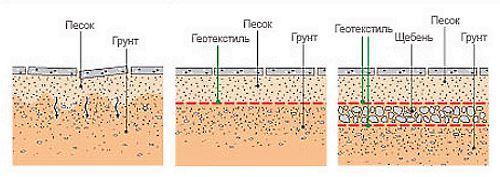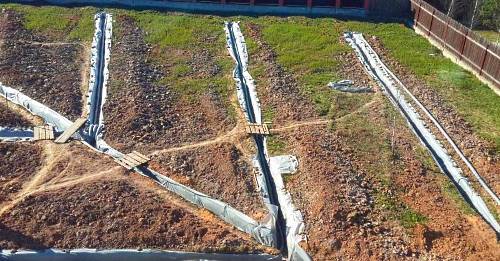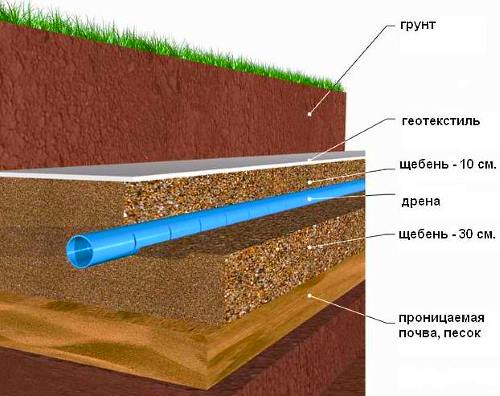How to properly drain your lawn?
Tell me how to make the correct drainage of the lawn on your own, without resorting to the services of landscaping specialists?
When planning to break a lawn on your own plot, you should carefully read the entire step-by-step algorithm of the planned work. The need for a drainage system directly depends on the quality characteristics of the soil for each specific area for cultivation. If stagnation of water resulting from irrigation or rainfall is not characteristic of the landscaped site, then the organization of the drainage layer is usually optional. But for a full-fledged lawn area that will delight the owner's eye all season and eliminate the need for unnecessary subsequent alterations and corrections, you should still provide for the implementation of this stage for breaking the lawn.
Read also the article: rolling lawn - laying and maintenance!
Preliminary analysis of site features
Analyze and determine the type of soil to be developed in this area. It is also necessary to read the area provided for landscaping activities. The creation of drainage under the lawn area is especially important for clay and loamy soils. Having decided on the size of the landscaped area, you can start digging the site, providing the most even surface throughout the excavated area.
Within the area planned for planting lawn grass, the soil surface should be carefully leveled, while removing the remnants of plant root systems, excess plant elements, large and medium stones, dry residues, debris and other side effects from digging.
Only if the cultivated plot of land is characterized by an increased sand content and a low level of clay occurrence, then the question of how to make the correct drainage of the lawn can be considered already solved.
In this case, the soil itself acts as an excellent natural drainage system, relieving future lawn plantings from the harmful effects of excess moisture and stagnation of excessive or normalized precipitation.
The opinions of landscaping specialists differ on this issue, but in order to ensure a full-fledged grass cover of the soil with lawn crops, one should still hedge and lay a local drainage structure. Such a system will protect against excess water due to unforeseen rains and waterlogging of the site later during the snow melt in the spring.
Modern varieties of drainage systems
With a competent approach to creating your own lawn area, the drainage layer is laid primarily following the completion of excavation, cleaning and leveling work. Today the following systems are the most effective:
- downstream, designed to divert flowing bottom water;
- upper, when using which moisture falling on the soil is effectively removed (for example, rain, snow)
- local, partially used for landscaping areas.
Many homeowners use this particular system. Such work is carried out in the shortest possible time and is quite simple:
- from 15 to 20 cm of the upper fertile layer;
- a 5 cm layer of subsoil is laid, filled with small stones, gravel, coarse sand;

It will not be superfluous to pay attention in advance to how the melt water flows down and what kind of movement of the accumulated water on the site as a whole.
Methods for constructing the main types of drainages
If the developed plot of land has been sufficiently studied, and its individual characteristics are determined, then it will not be difficult to think over and recreate an effective drainage system. It is enough to follow some simple rules.
Laying the base layer
Particular attention should be paid to the owners of sites with a clear predominance of clay in the composition. Such a layer will quickly and remove excess water. The work is carried out in the following order:
- filling up stones, gravel, broken bricks with a thickness of 10 to 15 cm;
- sand or fine screenings are stacked in the same amount;
- the final layer is the soil itself, intended for planting lawn crops.
Pay attention to the fact that each layer is carefully compacted.
Drainage channel systems
The channel drainage system is used in the case when the layer system does not bring, or simply cannot bring the desired result. In this case, the construction of wells or drainage ditches should be planned, while ensuring the maximum decorative effect for the system being created. A feature of the canal system is the laying of ditches taking into account the movement of melt water.

Drains - a system for particularly difficult areas
If greening works are planned on the territory of waterlogged soil (swampy area), but the previous methods will not be useful. In this case, the most optimal solution for removing excessive water is a drainage system. Drain placement is the laying of several pipes made of asbestos-cement material. In such a system, it is imperative to provide for a directional water drain.
